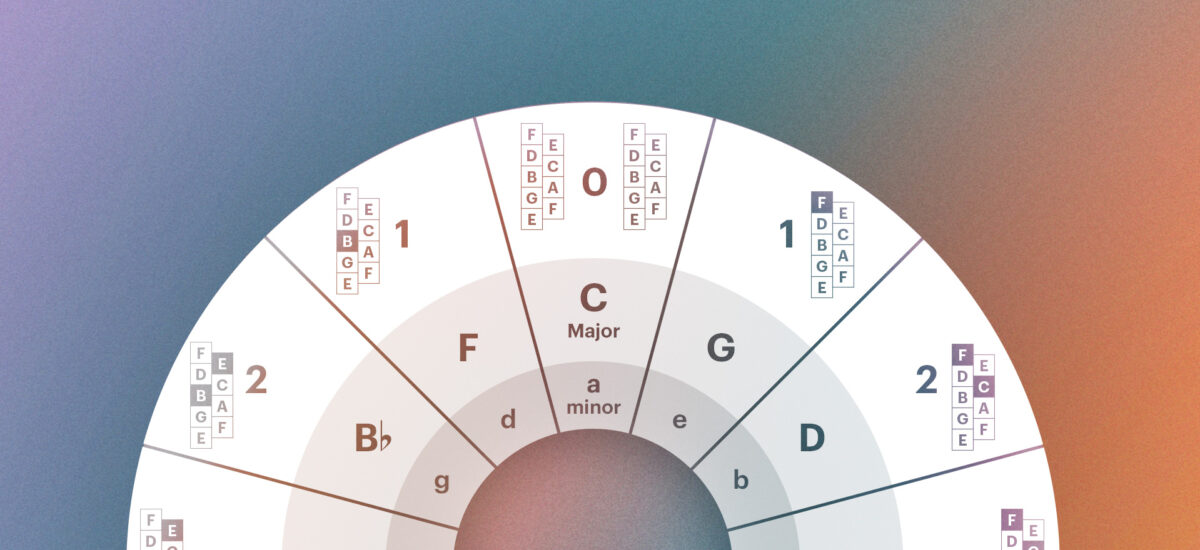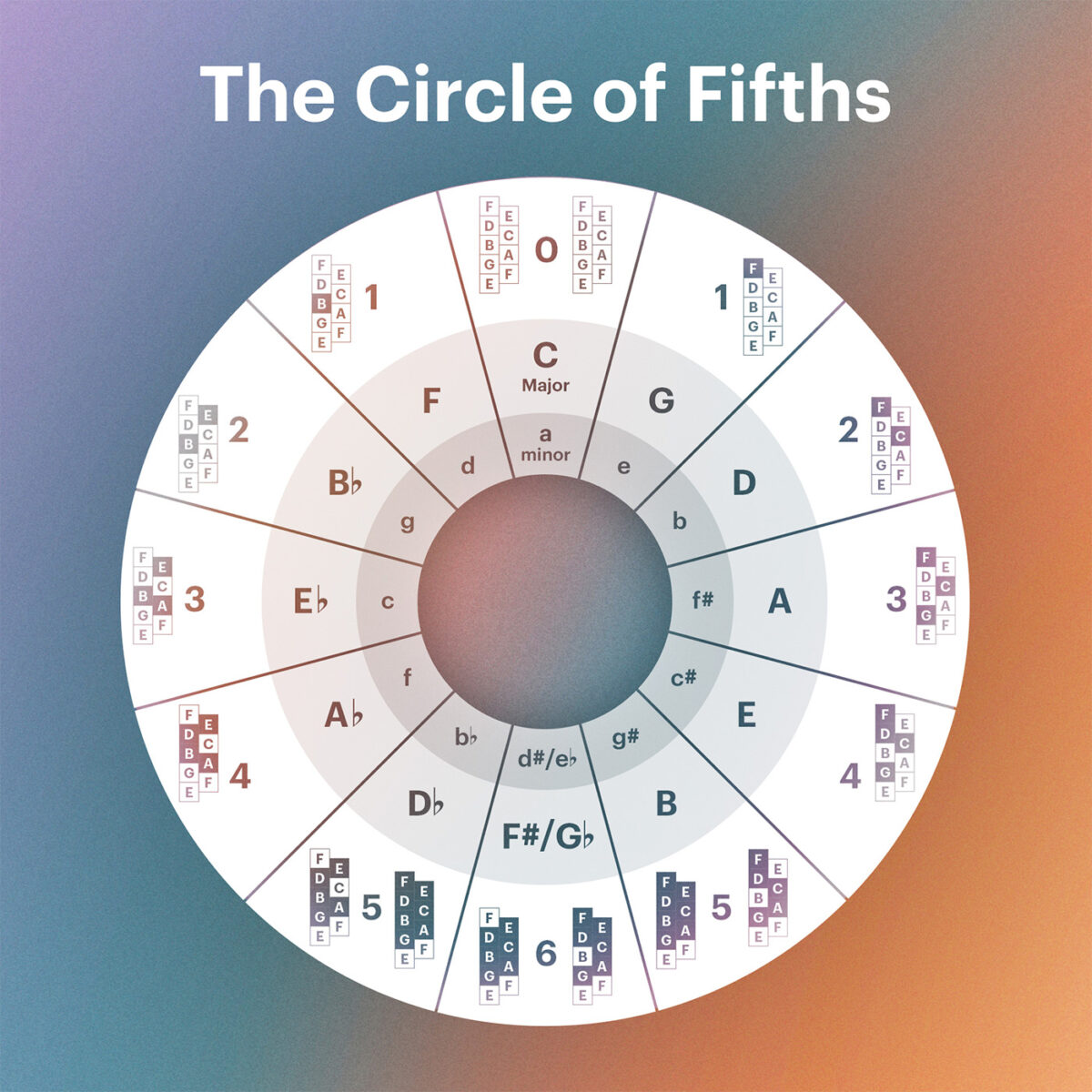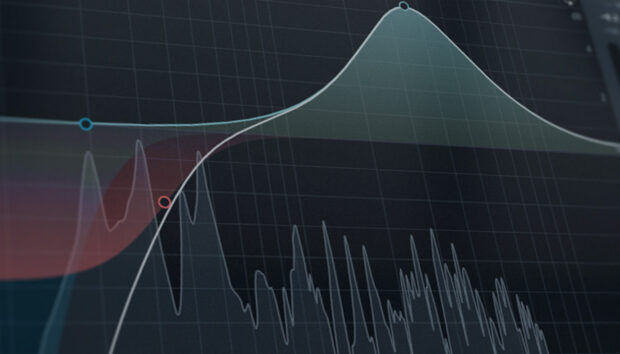
Whether you’re a music theory expert or just starting out, the circle of fifths is an extremely useful tool for all music genres. This handy concept can help you visualize the twelve musical keys and the notes that make up each scale. Additionally, it can help you remember key signatures, navigate your instrument, and unlock creativity with chords and progressions—all invaluable techniques for modern music producers.
Jump to these sections:
- What is the circle of fifths?
- How to use the circle of fifths
- Should you memorize the circle of fifths?
Try out the melodies and techniques in this blog using KOMPLETE START, a free collection of sounds, instruments, and more to kickstart your music creation journey.
What is the circle of fifths?
The circle of fifths is a diagram that shows the relationships between the 12 pitches of the chromatic scale. Each pitch in a clockwise direction is a perfect fifth higher than the next. Anti-clockwise, each pitch is a perfect fourth higher. The chart can be used to find the relative major and minor keys of any key, as well as to identify the key signatures of different root notes. Musicians also use the circle of fifths to help understand the relationships between different pitches and chords, and create chord progressions, key changes and melodies that are both pleasing to the ear and structurally sound.

How to use the circle of fifths
The circle of fifths is useful to understand key signatures and how many sharps or flats (accidentals) are in each scale of the 12 different types of key.
At the very top of the circle is the note C, which has a scale without any accidentals: C-D-E-F-G-A-B. Move one position in a clockwise direction and you next reach G which is a perfect fifth away, with a scale that has one accidental, an F#. Move one more position and you reach D, another perfect fifth, with two accidentals; F# and C#.
Conversely, each move in an anti-clockwise direction from C will introduce a perfect fourth into the scale. You’ll find that flat notes are introduced, notated as “b.” So from our base at C, move one position anti-clockwise for F, whose scale contains a single Bb. The next position brings us to Bb with two flat notes in the scale: Bb and Eb.
1. Find the relative minor key
It’s pretty simple to figure out the relative minor of a particular key using the circle of fifths. In a simple circle of fifths diagram you move 3 steps clockwise. For example, count 3 steps clockwise from C and you’ll come to A as the relative minor; C → G → D → A. For easy reference, in our circle of fifths chart we’ve shown a second inner ring of relative minors directly within the major chords.
2. Write natural sounding chord progressions
The circle of fifths is an extremely useful tool when it comes to writing chord progressions. Our diagram can help you figure out which chords will sound good when placed in sequence. As you can see in our diagram, there are two rings labeled with major and minor chords. Any chords that appear alongside one another on either ring will sound good together.
To explain, beginning at the uppermost root note of the chord on the circle of fifths and moving clockwise we will reach the fifth note of the chord. The note you land on will be the perfect fifth of the root note of that chord. For example, if you want to find the perfect fifth of the C major chord (C-E-G), start at the note C on the circle of fifths and move clockwise one step, reaching the note G. This is the root note of a G major chord (G-B-D). Moving one step anticlockwise from C will get you to F, the perfect fourth and another major chord (F-C-E). You’ll already know many simple songs that use these chords of C major, G major and F major; Happy Birthday, Ring of Fire, and Kumbaya.
The method works the same way regardless of which chord you start with on the circle, and it also works for minor chords. Relative minor chords are used routinely in many genres of songwriting and the circle of fifths can help you write using those chords too. As examples, the infamous 4 Chord Song uses Cmaj, Gmaj, Amin, Fmaj and the popular doo-wop progression shuffles these same 4 chords around to Cmaj, Amin, Fmaj, Gmaj. Both of these progressions are utilizing the relative minor of the root chord of C major, which is A minor.
Expanding this idea, you can group chords into blocks of 6 that sit next to one another on the circle. 3 of each major and minor chords in a block will always work well together. For example; Cmaj, Gmaj, Fmaj, Amin, Emin, Dmin. In fact, video game developer Naughty Dog used exactly this 6-chord system when developing the freestyle guitar playing mechanic for The Last Of Us 2. Writing a song using 6 chords will keep a song sounding natural, but don’t be afraid to mix things up, reaching for chords adjacent to this block of 6 to conjure more interesting chord changes.
Interested in learning more about music theory?

Join our community of more than 75,000 music creators and receive expert insights, tips, and tricks that will help you become a better musician and music producer.
3. Understand key changes and modulations in songs
It’s become a bit of a running musical joke that songs with a rising semitone modulation in the final chorus can sound rather cheesy. Nevertheless, this is still a popular technique to inject energy into the back end of a tune. Check out Beyonce’s “Love On Top” to hear 4 different semitone modulations as the song races to the finish line.
If you want to swerve this musical trope but still switch your song into a new key, you can use the circle of fifths to find alternative chords for a smoother modulation. The closer two chords are on the circle, the tidier the transition will sound. For example, modulating from C major to G major will sound very natural, as they are next door to each other on the circle and share the majority of their notes in a scale. Whereas moving from C major to E major will sound more abrupt, as those chords are further away on the circle and have fewer notes in common.
If you need to execute a move to a new key, but you can’t find your way there in just one modulation, try using pivot or passing chords to journey from one chord to another. Starting at your first chord, move through the circle of fifths one major or minor chord at a time, until you get to your final chord.
4. Break the rules
Once you’ve gained a solid grasp of the concepts behind the circle of fifths it’s time to experiment.
There’s nothing to stop you modulating keys throughout your song, as long as you tether the chord changes to a melody that your listeners can hang on to. This classic 80’s ballad from Sergio Mendes is a great example, modulating up and down during the verses but always sounding satisfying thanks to the solid leading melody.
Alternatively, use the circle of fifths to create a melody that is based on the notes of a different key (with a different number of accidentals), but closely related to the chords. Lady Gaga regularly uses this technique in her music to bring a sense of mystery and intrigue to the melody.
Another rule-breaking trick; try using the circle of fifths to create a chord progression that is outside of the key that you are in. This can create a sense of tension and release in your music as David Bennett expertly explains.
Should you memorize the circle of fifths?
The circle of fifths is just a tool to visualize how notes, key signatures, and chords relate to each other. You don’t need to memorize it to be a good musician. If you have a decent understanding of music theory, many of these concepts will already be familiar to you. With the circle of fifths they’re simply presented in a different, and perhaps more accessible way.
Use the circle of fifths to inspire your songwriting
The circle of fifths is a powerful tool that can take your music to the next level. It can help you understand why music sounds the way that it does, and it can be used to create chord progressions, melodies, and modulations. Once you know the rules, break out of the box and see what happens. You may be surprised at the unique combinations of notes and chords that you can create.















